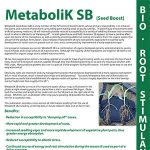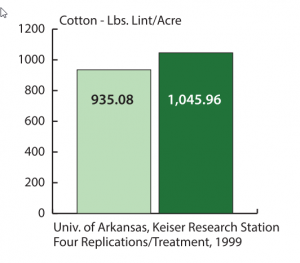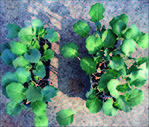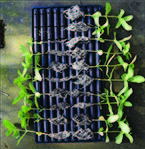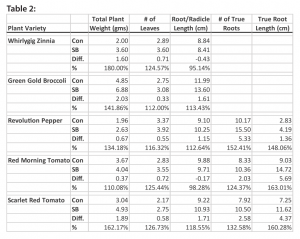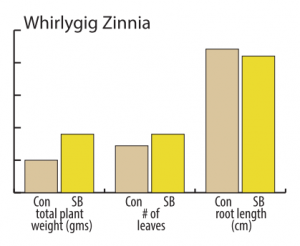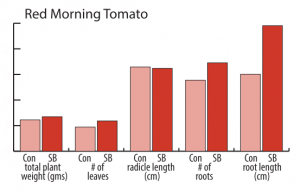MetaboliK Seed Boost (SB) is a key member of the ISP family of biostimulants, whose primary responsibility is to enhance the biome and nutrient environment surrounding germinating seeds or young cuttings. In greenhouse environments with artificial growing mediums, MetaboliK SB will indirectly provide reduced susceptibility to a variety of seedling diseases that commonly result in what is referred to as “damping off”. In both greenhouse and field situations, SB appears to have a positive effect upon the biome of the rhizosphere, as well as directly providing additional rooting stimulation from the organic acid(s) that are part of the product formulation. Data indicates improvement of early root growth, especially the essential early development of nodal roots on grasses such as corn, and a corresponding improvement of early vegetative vigor.
Using organic molasses as a carrier, MetaboliK SB is a combination of organic biological extracts, selected vitamins, auxins, trace minerals and a small amount of macronutrient. Although the majority of the ingredients are “organic”, SB itself is not approved for organic usage due to added macronutrients.
MetaboliK SB has many application options, including applied as a soak for trays of germinating seeds, as a mist over the top of seed trays, as part of a transplant solution, applied through drip lines following planting, or as part of a row place solution with field crops. Many produce growers also use it as part of a foliar program during the season. It is both quite easy to use and very economical.
Obviously, roots are important and any management practice that enhances development of a more vigorous root system will, in most instances, result in better plant vigor and yield potential.
“Successful emergence (fast and uniform) does not guarantee successful stand establishment of a vigorous nodal root system. Success is largely dependent on the initial development of nodal roots from roughly V2 to V9”
Purdue University, Corny News Network, May 2013

MetaboliK SB works to ensure this important aspect of your crop, as illustrated in the photo at right showing young corn plants from a trial in southwest Michigan. (Note both the number and length of the nodal roots on the SB plant on the right side of the Photo. Whether corn or whatever crop you’re growing, SB provides this foundation for a successful crop.
This publication provides a cross section of information resulting from the use of MetaboliK SB, including university data, in-house research data, and on-farm trials.
Benefits:
- – Reduction in susceptibility to “damping off” issues.
- – More rapid and greater development of roots.
- – Increased seedling vigor and more rapid development of vegetative plant parts, thus greater energy absorption.
- – Reduced susceptibility to abiotic stress.
- – Continued source of energy and root stimulation during the season if used as part of a foliar program.
- – Improved plant health.
- – More yield!
Some History …
MetaboliK SB was initially introduced in the mid 1980’s after research on a variety of seeds, including vegetables, field crop and grass. In many ways it performed even better than anticipated, definitely having a positive impact upon root development and seedling vigor. Taking SB to the university of Arkansas in 1999 we had them perform a project on cotton, as historically cotton seedlings are relatively susceptible to early stress. SB was applied 2″X2″ with liquid starter at a rate of sixteen ounces per acre, costing less than $8 per acre.
The results are illustrated in the graph at right, and although the overall yields are not that impressive compared with current cotton genetics, the difference was still quite positive with SB increasing yield 110.88 pounds of lint/acre (11.86%)
With crop prices continually going up or down, it can often be difficult to earn the profit we all want. An essential aspect of profit is the challenge of how to ensure or improve yield, at a cost that is less than whatever the value of the yield increases. In the University of Arkansas trial SB would earn greater profit so long as cotton prices were above 7 cents per pound of lint.
Corn is another crop where prices can often be challenging. In western Kansas, 2006, we performed a comparison project on three circles of irrigated corn. (The picture above illustrated one of the “comparison” sites, with the SB treated corn on the left side of the photo.)
There were subtle differences in the way the corn grew, but nothing that looked to be highly significant.
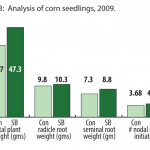
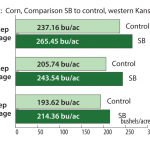
At harvest though, the yield differences were highly significant. The results are shown in Graph 2, with differences ranging from 37.8 bushels/acre (18.37%) to 20.74 bushels/acre (10.71%). Data indicated that part of the yield increase was due to stand uniformity, but there was also improvement in ear formation. Subsequent studies in other states averaged from 8% to as much as 12%, which at $8 per acre were all highly profitable.
We had seen several research papers indicating that early vigor is an important part of achieving higher yield, and we certainly agreed. This being so, we felt it was important to implement a study to determine exactly how we were impacting seedling development. Taking corn seed, we planted trays soaked with an SB solution and compared the results to a tray with just a water soak. These results are shown in Graph 3. There weas a visible difference in the two trays, with the SB treated seedlings being larger. After washing the growing medium from the roots, the seedlings were weighed and measured as to total plant characteristics: vegetative size and weight, and root development. Average plant weight of control seedlings was 39.7 grams. Average plant weight for the SB treated seedlings was 47.3 grams, an increase of 7.6 grams (19.14%)
Although we had also read that radicle and seminal root growth was determined by the vigor inherent in the seed itself, and could not be influenced by management practices, this was not what we observed. Overall radicle root mass was increased from 9.8 grams to 10.4 grams (5.10% increase), and both the number and mass of the seminal roots were increased from 7.3 to 8.8 grams (17.04% increase). Nodal root development was more advanced with an average of 3.68 nodal roots on the water soak, to 4.18 on the SB soak (13.58%). The conclusion was that SB was providing a similar level of root enhancement as seen in the initial studies.
Seedling vigor establishes the foundation for higher yield!
So, what about recent results?
This past season, (2017), we sponsored a similar project at the Penn State Research Farm at Manheim, PA. The project included Whirligig Zinnia, Green Gold Broccoli, Revolution Pepper and two varieties of tomato: Scarlet Red and Red Morning. As in the 2009 corn project, seeds were planted in trays, and then soaked in either a water solution, or an SB solution. Emergence data is shown in the table below. Although all showed faster emergence with SB, it was especially noticeable on the pepper and two tomato varieties.
On April 10 all of the plants were photographed, removed from the trays and washed to remove the growing medium, and photographed again. Cutting the plants at the soil level, the roots and vegetation were measured and weighed. All plant parts were then set aside to dry for seven days.
The photos below illustrate visual differences between the water soak and Seed Boost soak.
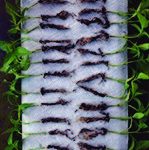
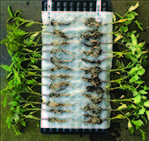
Table 2 below provides data from each of the trials, and except for root length with Whirligig Zinnia, and the radicle length on Red Morning tomato, all aspects of seedling development was improved. Increased root mass has a definite effect upon potential nutrient uptake, as soil/root contact and potential nutrient availability is increased. In addition, with the increase in vegetative parts of the plant, the seedlings can absorb additional sunlight, thus potentially increasing overall plant energy potential.
As mentioned, virtually every aspect of plant development was enhanced with MetaboliK SB. As the photo above right illustrates, there were certainly even greater differences, in overall root formation due to an increase in the smaller feeder roots which were impossible to either completely untangle or measure. This increase in overall soil/root contact should, in most cases, improve early fruit set in tomatoes, peppers and other multi-fruiting plants.
SUMMARY: MetaboliK SB is both versatile and economical. Mixing easily with all known liquid nutrient, it can be applied as a seedling soak, row place, a component of transplant solution, through drip irrigation, or even as a foliar additive, especially in smaller contained growth environments.


